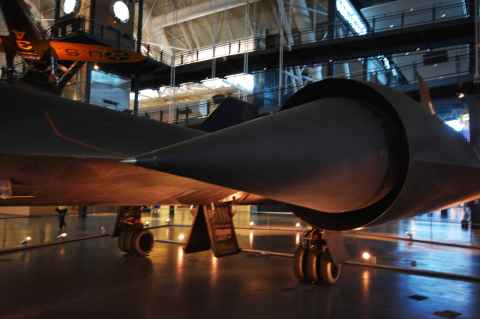The Wikipedia article on the Lockheed SR-71 Blackbird[a] states:
This configuration is essentially a ramjet and provides up to 70% of the aircraft's thrust at higher Mach numbers. Ben Rich, who designed the inlets at Skunk Works, often referred to the engine compressors as "pumps to keep the inlets alive"
The Wikipedia article on the J58 engine provided more detail:[c]
The propulsive thrust distribution between these components changed with flight speed.
at Mach 2.2 inlet 13% - engine 73% - ejector 14%
at Mach 3.0+ inlet 54% - engine 17.6% - ejector 28.4%
This was a source of great confusion to me. How could the inlet provide thrust? Didn't a jet engine get thrust from expelling gas a very high speeds and pressure from the back? How could something un-powered, like an inlet, provide any additional energy to move the aircraft forward?
So I set out to find out.
The short version is this: The function of the inlet during supersonic flight is to slow air down to about Mach 0.4, which is the speed at which air moves through the J58 jet engine[e], irrespective of the speed of the SR-71. This is done by shaping the inlet so that a system of oblique shocks are created when supersonic air is entering it. As the air passes through these shocks, it loses speed and gains static pressure. This pressure then pushes against parts of the inlet, and this is the "thrust" that it provides.
It should be noted that unless the J58 engine sucks air through the inlet, the system of shocks will not be stable, nor will this system exist unless the J58 engine has propelled the aircraft to the required speed, nor is this thrust enough to sustain the aircraft's speed. There is no free energy being created.
Most of what I read comes from this thread at PPRuNe: Concorde Engine Intake Thrust[f], which, although not a SR-71, shares a lot of the supersonic aerodynamics with it. Here is a good technical description[g], and here is a thread summary[h]:
By sucking a huge amount of air through a very sophisticated inlet, it sets up pressures in that inlet, that provide about 75% of the thrust.
By blowing that same amount of air, with added heat energy from the fuel, out of the other end, through another sophisticated convergent-divergent nozzle, we produce yet more thrust.

Lockheed SR-71. Note the cones sticking out of the intakes. They are inlet cones[j].
2009-05-15 11:14

